Image of a construction system that utilizes resources on the moon
In Japan, the government has begun full-scale efforts to foster space startups. The total amount of funds invested is a huge amount of 38.76 billion yen.
A typical company receiving grants is iSpace, which attempted to land on the moon in April 2023, and received up to 12 billion yen. Interstellar Technologies, a private rocket developer known for being founded by Takafumi Horie, and SPACE WALKER, a venture from the Tokyo University of Science that develops reusable winged rockets, each have 2 billion yen (up to 140 million yen in stages). billion yen)——.
These budgets are based on the framework of the “Small and Medium Enterprise Innovation Creation Promotion Project (SBIR Phase 3)” by the Ministry of Education, Culture, Sports, Science and Technology and the Ministry of Economy, Trade and Industry.16 space startups were selected as targets..
Considering that the total amount of funding for domestic space ventures in 2022 will be 34.5 billion yen, we can see the magnitude of the impact that this government grant will have on the industry.
The selected businesses include notable space ventures. Let’s take a look at the selected companies in each business area and the maximum grant amount.
ispace received 12 billion yen.Developing a new lunar lander
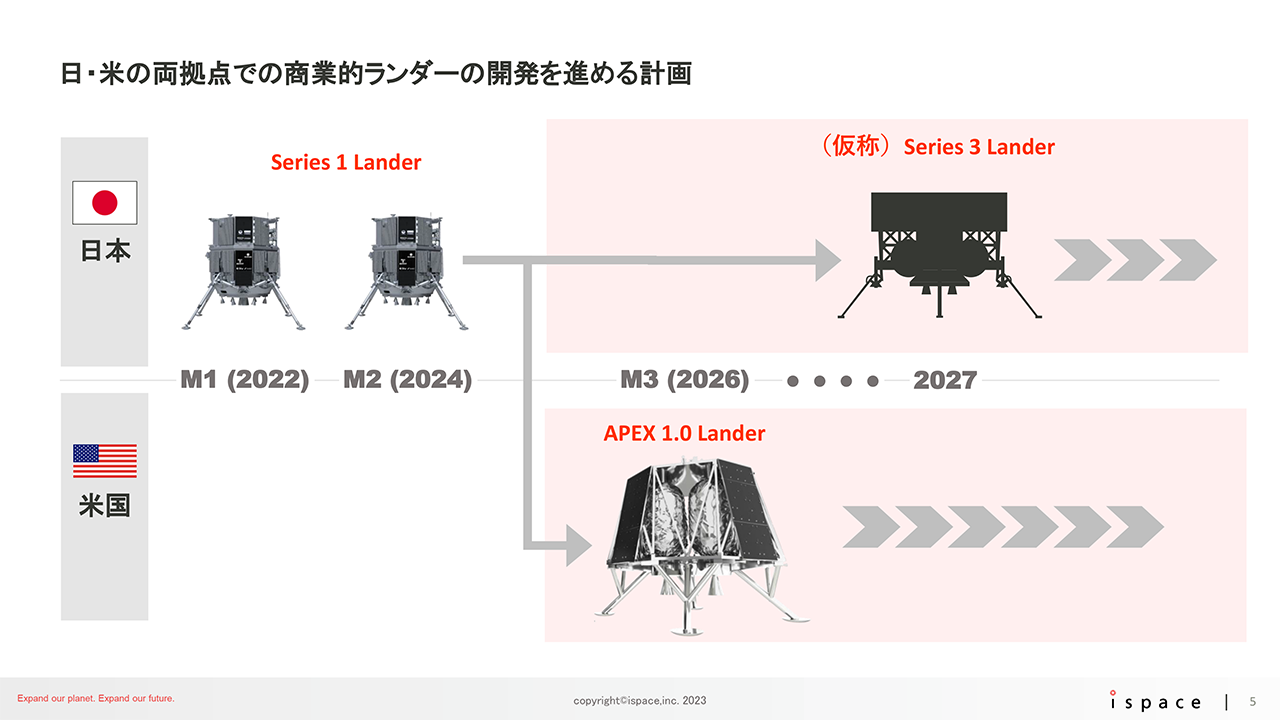
The APEX 1.0 lander, which can carry a payload of up to 300 kg, is scheduled to be launched in 2026, and the Series 3 Lander (tentative name), which can carry payloads of 100 kg or more, is scheduled to be launched in 2027.
iSpace, which attempted to land on the moon in April 2023, will receive up to 12 billion yen in SBIR from the Ministry of Economy, Trade and Industry. According to the Nomura Research Institute, which supports SBIR, iSpace was the only company to apply for the public theme of “Development and operational demonstration of a lunar lander.”
In parallel with the new lander “APEX 1.0 Lander” being developed mainly by its American subsidiary, ispace will use subsidies to develop a new lunar lander “Series 3 Lander (tentative name)” led by its Japanese headquarters. .
At a question-and-answer session for the media held on October 23, CEO Takeshi Hakamada explained that operating two landers will be an important pillar of the business.
The APEX1.0 lander, which is currently under development in the United States, will incorporate the requirements of NASA, which is leading the Artemis program, and the American government, and will provide transportation services mainly to the American market. On the other hand, the Series 3 Lander will be developed for markets outside the United States, with the aim of capturing demand.
CEO Hakamada
“We believe that our company is far ahead in this kind of development (with an eye on markets outside the United States), and we believe that this strategy is important as a competitive advantage for our business.”
I said.
Advertisement
A total of 16 selected companies
There are other notable ventures besides ispace. Below is a summary of the business theme, company name, maximum grant amount, and company overview.
◯Project theme: Development and demonstration of private rockets (adopted by the Ministry of Education, Culture, Sports, Science and Technology)
Interstellar Technologies (upper limit on grant amount: 2 billion yen)
A company founded by businessman Takafumi Horie, also known as “Horiemon.” The sounding rocket “Shift to Space Quality MOMO3” launched in May 2019 became the first private company in Japan to reach outer space. Then, in July 2021, two sounding rockets reached outer space in succession. Currently, we are developing a small rocket called “ZERO” for inserting satellites into orbit.
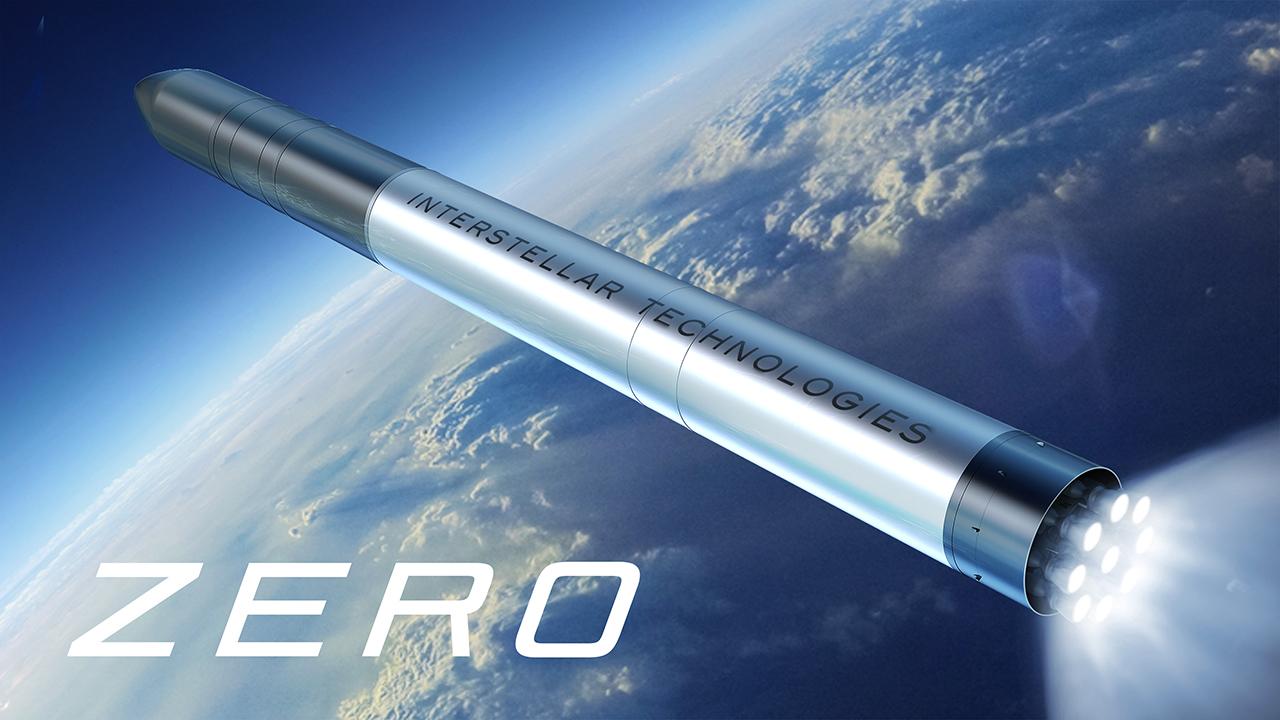
Image of “ZERO”. The company uses liquefied biomethane produced from livestock manure in the Tokachi region of Hokkaido, where it is based, as fuel.
SPACE WALKER (upper limit of grant amount 2 billion yen)
A venture from Tokyo University of Science. He is working on the development of winged reusable rockets, based on the research and development of spacecraft carried out by the Ministry of Education, Culture, Sports, Science and Technology’s Space Science Institute (currently JAXA Space Science Institute) and the National Space Development Agency (NASDA). . He is also developing, manufacturing, and selling next-generation composite tanks by repurposing lightweight technology. A flight demonstration to provide a small satellite launch service is scheduled to be conducted in 2027.
Future space transportation system (upper limit of grant amount 2 billion yen)
A startup aiming to develop a reusable space transport vehicle. Since its founding in May 2022, the company has been conducting joint research with Muroran Institute of Technology, Tokyo University of Science, and Chiba Institute of Technology, and has entered into partnerships with IHI, IHI Aerospace, Shimizu Corporation, and others.
Space One (upper limit on grant amount: 320 million yen)
A venture established with investment from Canon Electronics, IHI Aerospace, Shimizu Corporation, and Development Bank of Japan. Currently developing a small rocket called “Kairos”. The first Kairos was scheduled to launch in February 2023, but the launch was postponed due to difficulties in procuring parts from overseas due to the global logistics disruption caused by the coronavirus pandemic.
◯Project theme: Technology development and demonstration necessary for space debris reduction (adopted by the Ministry of Education, Culture, Sports, Science and Technology)
Astroscale (upper limit on grant amount: 2.69 billion yen)
The world’s first private space debris removal technology demonstration satellite “ELSA-d” was launched in March 2021 and successfully captured simulated debris. The core technologies necessary for space debris removal, including rendezvous technology, were demonstrated.
The actual commercial debris removal demonstration satellite “ADRAS-J” developed by Astroscale was shown to the press. The plan is to get close to the target debris to the point where you can reach it with your hands.
JAXA was selected for Phase I of the “CRD2” program, which promotes the creation of a space debris countermeasure market in collaboration with private businesses, and has developed the commercial debris removal demonstration satellite “ADRAS-J.” It plans to approach the upper stage of the H-IIA rocket that remains in orbit and take images of the movement, damage, and deterioration of debris that has been left for a long time.
Pale Blue (upper limit on grant amount: 1.58 billion yen)
A venture from the University of Tokyo. Hydrazine and xenon, which are used as propellants in conventional satellites, have issues such as being highly toxic and expensive to handle, so Pale Blue has developed a “water engine” that uses water as a propellant. It has a track record of being installed on the microsatellite “EYE” launched by the Sony Group as part of the “STAR SPHERE Project”.
BULL (upper limit on grant amount: 1.47 billion yen)
A startup founded in November 2022 by Kyoji Uto, who was the manager of the space debris diffusion prevention device development at ALE, which develops artificial shooting stars. In July 2023, we took over the assets related to ALE’s space debris countermeasures business, and began joint demonstrations with JAXA to commercialize space debris diffusion prevention devices. In October 2023, it was certified as a Teikyo University startup.
The Ministry of Economy, Trade and Industry has selected the above-mentioned ispace for the “Development and Operational Demonstration of Lunar Lander (Lander).” In addition, the following eight companies have been selected.
◯Business theme: Satellite remote sensing business advancement demonstration (adopted by the Ministry of Economy, Trade and Industry)
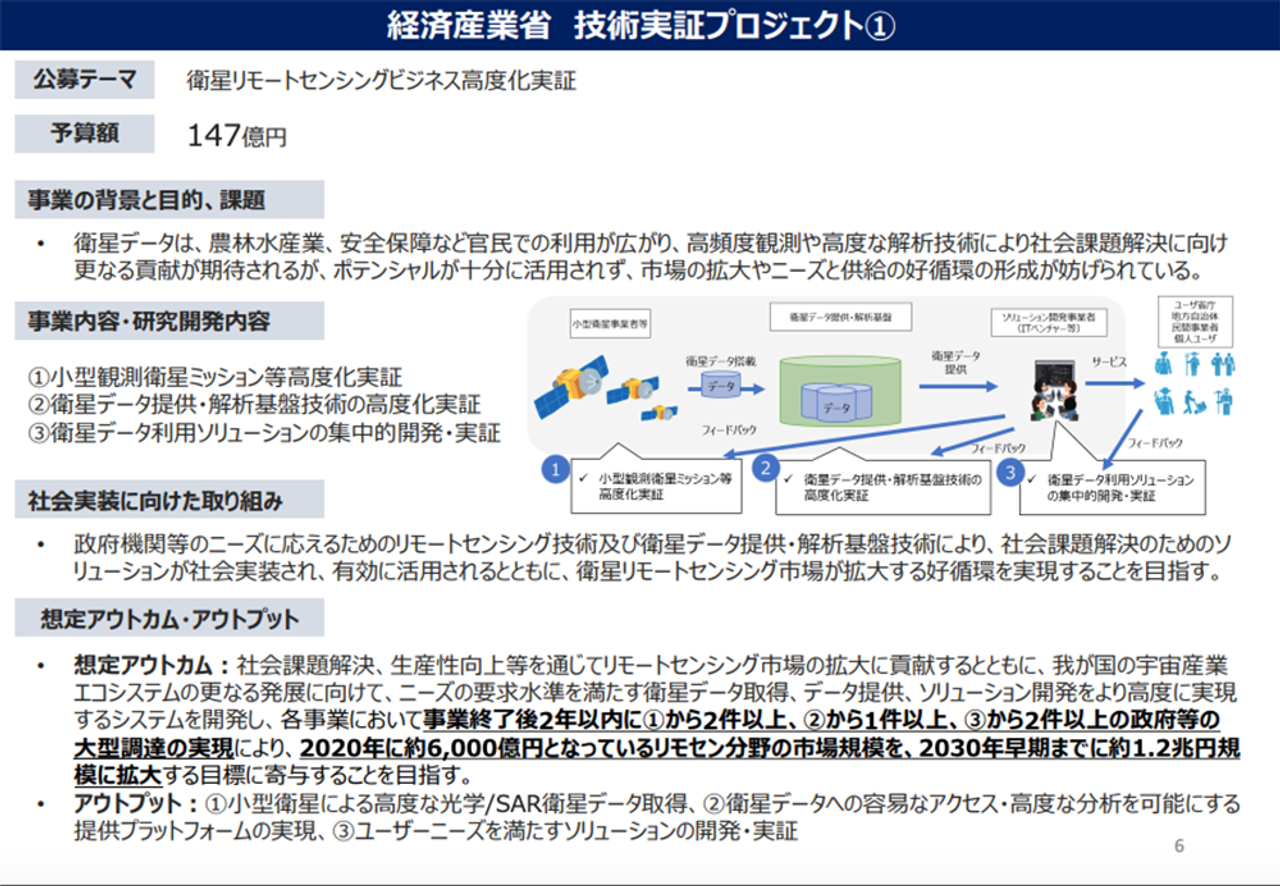
There were 11 applications for the “Satellite Remote Sensing Business Advancement Demonstration”, and 8 were selected.
Synspective (upper limit on grant amount: 4.1 billion yen)
The company launched its own small SAR satellite that applied the results of the Cabinet Office’s Innovative Research and Development Promotion Program (ImPACT), sells the observed data, and provides solutions for assessing flood damage and analyzing ground deformation. In March 2022, the company raised 11.9 billion yen in the Series B round, bringing the total amount raised to 22.8 billion yen.
Arc Edge Space (upper limit on grant amount: 3.5 billion yen)
A startup from the University of Tokyo that plans, develops, and operates microsatellites, and proposes communication and earth observation services. It was applied as a consortium with Genesia, AstraSens, Bank of Mitsubishi UFJ, Skymatics, Tokyo Institute of Technology, and others, and was selected.
QPS Institute (upper limit on grant amount: 4.1 billion yen)
A venture from Kyushu University. The company is building a constellation of small SAR satellites, aiming to realize a “near-real-time data provision service” that can observe most specific areas around the world at an average interval of 10 minutes.
New Space Intelligence (upper limit on grant amount: 1.5 billion yen)
A startup founded by members of Yamaguchi University and the Asian Institute of Technology (Thailand), who have specialized knowledge in satellite remote sensing, AI technology, and image processing. We are developing a “satellite data pipeline” that automates the series of processes involved in using satellite data and provides data according to user needs.
sustainacraft (upper limit on grant amount: 430 million yen)
A startup that provides a service to evaluate the effectiveness of nature conservation projects by combining satellite remote sensing technology and causal inference technology. We are conducting joint research with the National Institute for Environmental Studies and Hitotsubashi University to create carbon credits.
Tenchijin (upper limit on grant amount: 430 million yen)
A JAXA-originated venture established by JAXA staff and members with knowledge of agricultural IoT. Utilizing satellite data, we offer a service for local governments that manages the risk of water pipe leakage, and a service that uses satellite data to comprehensively analyze information such as weather and topography to identify suitable areas for cultivating crops. We provide search services, etc. In December 2022, it was announced that it had received investment from JAXA.
LocationMind (upper limit on grant amount: 280 million yen)
Startup from the University of Tokyo. We conduct location information analysis using location big data and IoT devices, human flow prediction, and consulting. Selected together with IHI and Arcedge Space for the New Energy and Industrial Technology Development Organization (NEDO)’s “Economic Security Important Technology Development Program/Development and Demonstration of Marine Situational Awareness Technology Using Communication Satellite Constellations for Ships” .
Sagri (upper limit on grant amount: 360 million yen)
Overview: Utilizing satellite data and AI technology, the company offers apps such as Sagri, which helps agricultural producers streamline field management, and Detaba, an app that streamlines cropping surveys.
The system that has existed since 1999 will be upgraded in a five-year plan.
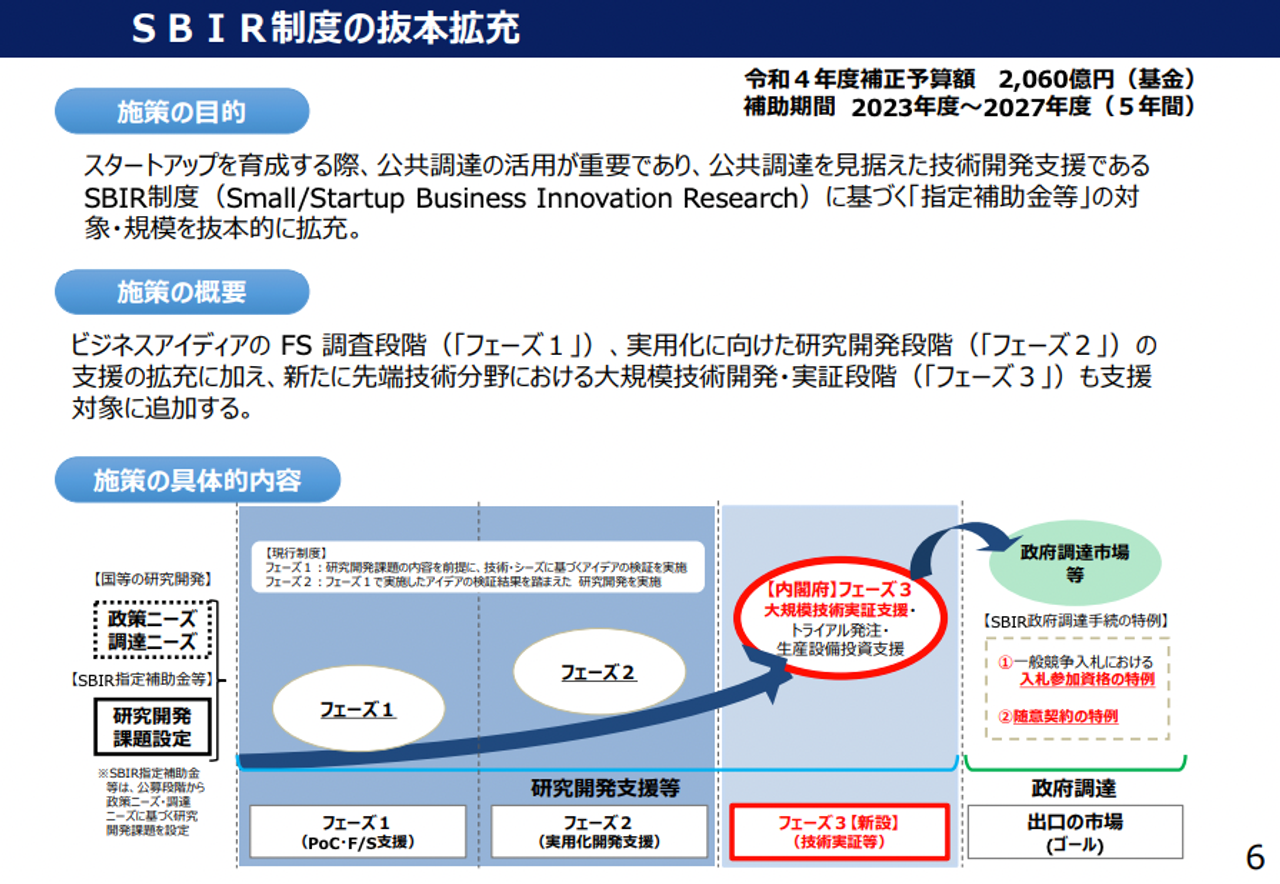
From “Recent trends in space policy.”
SBIR, which will provide grants to 16 space startups, is a system that originally started in the United States and aims to create innovation by promoting research and development by startups and implementing the results in society. In the United States, 11 federal agencies have participated, including the Department of Defense, Department of Health and Human Services, Department of Energy, National Aeronautics and Space Administration (NASA), and National Science Foundation, to support startup research and development. For example, ICON, a startup that builds houses using 3D printers, has been selected for NASA’s SBIR program and is working on developing construction technology for lunar and Mars bases.
Following the example of the United States, the SBIR system began operating in Japan in 1999.
Japan’s SBIR centered around “Phase 1”, which explored the feasibility of an idea, and “Phase 2”, which carried out research and development based on the results of verifying the idea.
However, the problem with previous SBIRs was that support for the demonstration phase was limited.
Amid calls for improvements to the system, the “Five-Year Startup Development Plan” formulated in November 2022 includes “(Japan (edition) “Dramatic review of the SBIR system and promotion of public procurement” was included. What was newly established was SBIR’s “Phase 3,” which supports large-scale technology development and demonstration in cutting-edge technology fields and promotes commercialization based on research and development.

From “Recent trends in space policy.”
The main requirements for SBIR Phase 3 from the Ministry of Education, Culture, Sports, Science and Technology and the Ministry of Economy, Trade and Industry are, in principle, startups with cutting-edge technology that have been established within 15 years or consortiums that utilize the technology of the companies in question.
The selected projects are not only in the space field, but also include “nuclear fusion” and “flying cars,” but the scale of the budget for the space field is…The Ministry of Education, Culture, Sports, Science and Technology spent 55.6 billion yen out of a total of 66.1 billion yen for selected projects.According to the Ministry of Economy, Trade and Industry, 26.7 billion yen out of 51.38 billion yen in all selected projects.It stands out.
From the end of September to October of this year, the Ministry of Education, Culture, Sports, Science and Technology will conduct research on a total of seven companies in two business areas: “Technology development and demonstration necessary for space debris reduction” and “Technology development and demonstration necessary for space debris reduction.” Nine companies were selected in the space field for the business areas of “Lunar Lander Development and Operational Demonstration” and “Satellite Remote Sensing Business Advanced Demonstration”.
The Ministry of Education, Culture, Sports, Science and Technology divides selected projects into three stages and provides funds according to the progress of the project, so the support decided for this time is only a portion of 12.06 billion yen, but still.This adoption by the Ministry of Education, Culture, Sports, Science and Technology and the Ministry of Economy, Trade and Industry will result in a “huge amount of government funding” totaling up to 38.76 billion yen flowing into the space field.It turns out.
Support from the public sector to the private sector in the space field
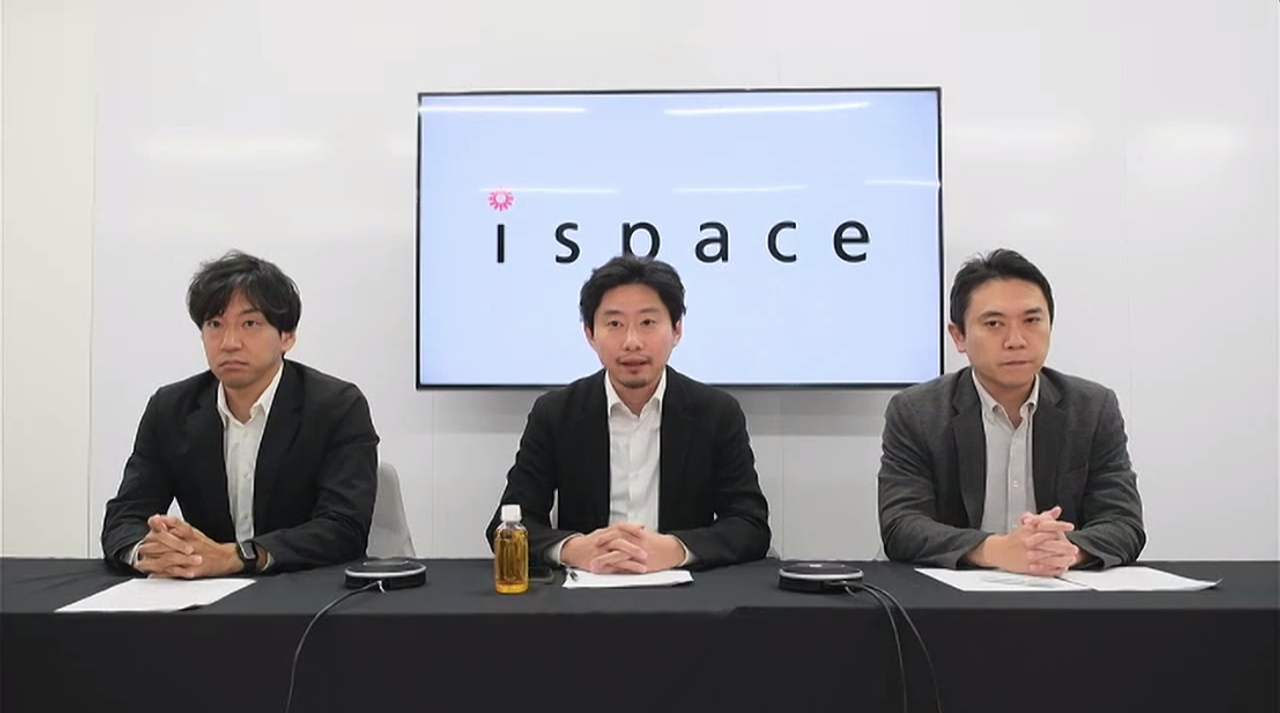
iSpace’s online question and answer session was held on October 23rd. At the center is ispace CEO Hakamada.
In the space industry, including SBIR, support from the public sector to the private sector is expected to have a significant effect.
In particular, the growth of American space ventures is largely due to government support. SpaceX is a prime example. SpaceX’s Dragon supply ship, which transports supplies to the International Space Station (ISS), was developed with support from NASA’s Commercial Orbit Transportation Services (COTS) program.
NASA supported the technology development of selected companies and also played a role in attracting private investment by promising to purchase transportation services. NASA is currently implementing similar support programs in areas such as the development of transportation services to the lunar surface.
In Japan, the Ministry of Education, Culture, Sports, Science and Technology has indicated that rockets that have successfully completed test flights in the SBIR’s “Private Rocket Development and Demonstration” business area and meet the requirements will be adopted for launching government-related satellites. . Similarly, in the area of “development and demonstration of technologies necessary to reduce space debris,” there is a possibility that technologies developed by private companies that have been successfully developed will be adopted in government projects.
Although there is no clear mention of government procurement in the Ministry of Economy, Trade and Industry’s “Development and Operational Demonstration of Lunar Lander,” iSpace CEO Hakamada expressed his expectations during a question-and-answer session.
“Since the requirement is for a transport capacity of 100 kilograms or more, I believe that the Ministry of Economy, Trade and Industry is anticipating such demand. Japan is beginning to see a direction in which it will invest in building infrastructure around the moon in accordance with the plan (a plan that indicates the direction of the country’s space policy), so we believe that transportation needs will definitely emerge. I’m here.”
With the government’s strategic support for space startups, the day may come when unicorn companies will emerge from the space field in Japan as well.
(Edited by Takashi Mitsumura)
Source: BusinessInsider
Emma Warren is a well-known author and market analyst who writes for 24 news breaker. She is an expert in her field and her articles provide readers with insightful and informative analysis on the latest market trends and developments. With a keen understanding of the economy and a talent for explaining complex issues in an easy-to-understand manner, Emma’s writing is a must-read for anyone interested in staying up-to-date on the latest market news.

